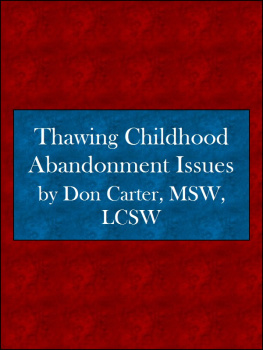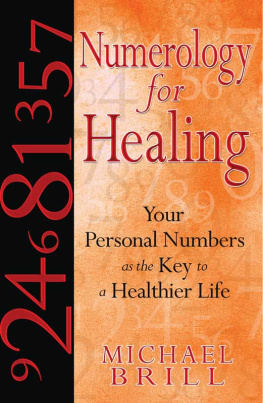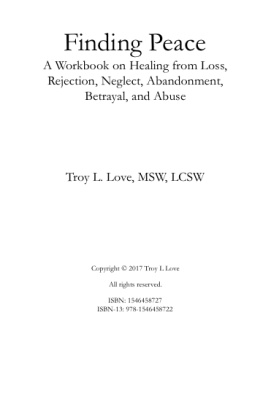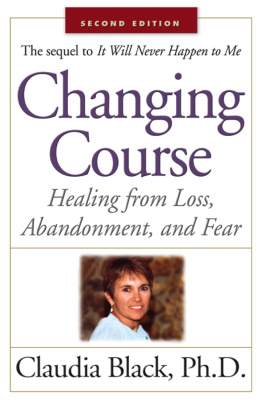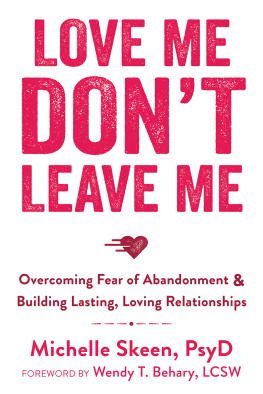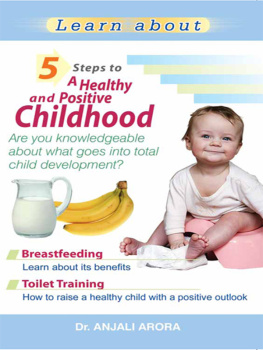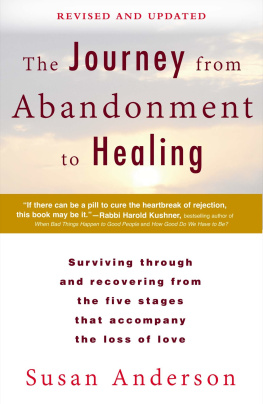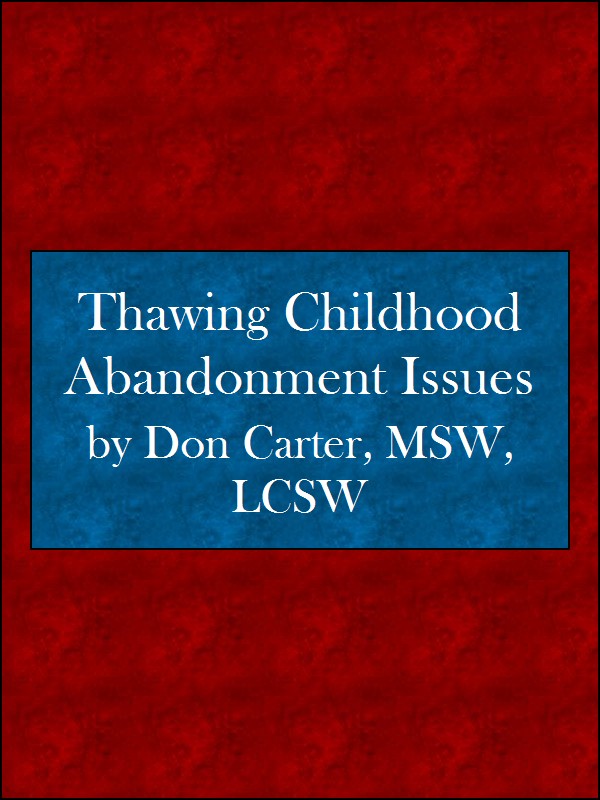Table of Contents
Thawing Childhood Abandonment Issues
By: Don Carter, MSW, LCSW
Copyright 1995 - 2014 Don Carter, MSW, LCSW
All rights reserved. Printed in the United States of America. No part
of this document may be used or reproduced, stored in a retrieval system,
or transmitted, in any form or by any means, electronic, mechanical,
photocopying, recording, or otherwise, without the prior written permission
of the author except for brief quotations, with proper references
embodied in other writings. For information address:
www.Internet-of-the-Mind.com
Email: dcarter73@msn.com
Phone: (573) 634-2254
Or Write to:
Don Carter, MSW, LCSW
83 South Larand Dr.
Lake MyKee
Holts Summit, MO 65043
TABLE OF CONTENTS
Motivation, Maslows Hierarchy of Needs, Childhood Dependency Needs, Iceberg Model
Abandonment, Shame, Contempt, the False Self (Unmet Childhood Needs)
External Focus, Invented Self, Impression Management (Codependency)
The True Self, Spirituality vs. Religion
Pain as a Motivator, Emotional Attachments, Healthy Relationships, Hitting Bottom
Reaching Out, Recovery from Codependency, Unmet Childhood Needs, and Addictions A Hard Sell, Prescription for Recovery, What Next?
Chapter 1
What the hell is wrong with you?
Comedian Bill Cosby has often observed that one of a childs most frequent answers to questions posed by their parents is I dont know. He forgets to mention that one of a parents most frequent questions to their children is some variation of What the hell is wrong with you? I always hated that question. How was I supposed to answer it? Well, Dad, Im very happy you asked because I think we really need to talk about this. You see, my childhood dependency needs have not been getting met lately and, as a result, I am suffering from a pretty bad case of low self-esteem and some abandonment issues. If you could see your way clear to lighten upon me a bit I might have a chance to get back on track. I doubt that would have gone over very well.
I am not sure that my alternative approach was much better for my own kids. I modified the question into a little game. When I found myself wanting to ask one of them, What the hell is wrong with you? I would stop, raise an eyebrow just a bit, look at them for a moment, and then curiously inquire, What grade are you in? They would give the answer to which I would smile and say, Oh that explains it! Maybe they dont teach you about this until next year.
Motivation
Motivation has been defined as a drive, a need, a desire to do something. In human beings, motivation involves both conscious and unconscious drives. It is this writers belief that people all have one ultimate motive in common. This motive drives everything we think, everything we feel, and everything we do from the time we wake in the morning until we go to sleep at night. I believe this motive is simply to be happy.
In this case, the term happiness does not necessarily refer to a feeling or emotion. Feelings come and go so it is not realistic (nor desirable) to hope to stay in one emotional state. Rather, used in this context, happiness is more like a universal state of being that describes and contains other states of being such as: contentment, satisfaction, fulfillment, completeness, and wholeness. Again, it is this pursuit of happiness that is at the root of everything we think, everything we feel, and everything we do. We all have this same ultimate goal in common, and we are all doing the best we can with what we have to get as close to that ideal as possible. If all of our efforts fail, and we move too far away from the ideal then things can go very wrong, as in the case of someone who can feel empty, unhappy, and unmotivated.
As our ultimate goal in life, the desire to be happy motivates us to make decisions based upon what will move us closer to the positive end of a continuum. On the negative end of this continuum is pain, something we try very hard to stay away from. Most of us do not like pain, but it does have a very important role in our lives. Pain is a warning system that tells us when we are moving in the wrong direction, taking us further away from our ultimate goal.
Granted, we sometimes purposefully make decisions that we know are going to hurt, in the short-term anyway. However, even these painful decisions are driven by the desire to be happy because we know that in the long run we will gain from the short-term pain. For example, deciding not to marry the person of our dreams until we finish college and get our finances in order may be painful in the short-term but very rewarding in the long run. It may even play a part in whether the marriage succeeds or fails. When we make decisions like this, we are said to be mature because we can delay gratification.
There are other times we make decisions that dont make us happy such as when we act without hesitating long enough to think it through. For example, impulsively taking out a new line of credit or buying a new car when we cannot afford it may provide some instant gratification but soon leads to buyers remorse and other negative long-term consequences when the bills start coming in. Buyers remorse is an example of an emotional consequence we suffer when we realize what we have done and how it is going to lead to our future unhappiness. When we dont stop and think it through before we act, we are said to have impulse control problems, a sign of immaturity.
When immaturity persists into adulthood it suggests that some sort of developmental delay has taken place such as emotional arrest. Developmental delays are usually the consequence of unmet childhood needs. Frozen feeling-states are another way of describing these developmental issues. We will explore these concepts in great detail throughout this book. We will also explore a very simple, yet incredibly powerful formula, A {MISSING SYMBOL Wide-headed rightwards arrow} B ( {MISSING SYMBOL Wide-headed rightwards arrow} = leads to). This formula is where A is a choice we make and B is the outcome. The outcome is where we find ourselves on the pleasure and pain continuum as a consequence of our choice.
Maslows Hierarchy
The American psychologist Abraham Maslow (1968) devised a six-level hierarchy of needs that, according to his theory, drive human behavior. I believe that each of these needs must be met in order for one to truly be happy. Maslow progressively ranks human needs as follows:
Physiological - food, shelter, clothing;
Security and safety;
Love and feelings of belonging;
Competence, prestige, and esteem;
Curiosity and the need to know; and
Self-Actualization
Maslow suggests that each preceding need must be met, at least to some degree, before one can go on to the next level. For instance, a child may not be able to pay attention in class if she is preoccupied with hunger. Maslow refers to the first four levels as deficiency needs and the last two growth needs.
While these needs are important for all human beings, special attention must be given to how we meet these needs in children because, as we shall see, it is the meeting of these needs, or not meeting them, that sets in motion a whole series of events that have an impact on the adjustment of that child. In children, deficiency needs are also referred to as dependency needs because children cannot meet these needs themselves; they depend upon their caretakers to meet these needs for them.

